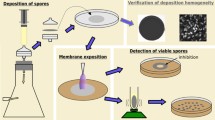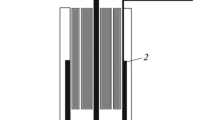Abstract
The inactivation of four micromycete species by action of non-thermal plasma was followed. Two sources of plasma were compared, namely, positive corona discharge and dielectric barrier discharge. The corona discharge appeared as suitable for fungal spore inactivation in water suspension, whereas the barrier discharge inactivated spores on the surface of cultivation agar. Cladosporium sphaerospermum was the most sensitive, being inactivated within 10 min of exposure to plasma, whereas Aspergillus oryzae displayed decrease in viable cell count only, the complete inactivation was not achieved even after 40 min of exposure. Intermediate sensitivity was found for Alternaria sp. and Byssochlamys nivea. The significant delay of growth was observed for all fungi after exposure to sublethal dose of plasma, but we failed to express this effect quantitatively.







Similar content being viewed by others
References
Akishev Y, Grushin M, Karalnik V, Trushkin N, Kholodenko V, Chugunov V, Kobzev E, Zhirkova N, Irkhina I, Koreev G (2008) Atmospheric-pressure, nonthermal plasma sterilization of microorganisms in liquids and on surfaces. Pure Appl Chem 80:1953–1969. doi:10.1351/pac200880091953
Cha S, Park YS (2014) Plasma in dentistry. Clin Plasma Med 2:4–10. doi:10.1016/j.cpme.2014.04.002
Ehlbeck J, Schnabel U, Polak M, Winter J, von Woedtke T, Brandenburg R, von dem Hagen T, Weltmann K-D (2010) Low temperature atmospheric pressure plasma sources for microbial decontamination. J Phys D ApplPhys 44:13002. doi:10.1088/0022-3727/44/1/013002
Elmoualij B, Thellin O, Gofflot S, Heinen E, Levif P, Séguin J, Moisan M, Leduc A, Barbeau J, Zorzi W (2012) Decontamination of prions by the flowing afterglow of a reduced-pressure N2–O2 cold-plasma. Plasma Process Polym 9:612–618. doi:10.1002/ppap.201100194
Graves DB (2012) The emerging role of reactive oxygen and nitrogen species in redox biology and some implications for plasma applications to medicine and biology. J Phys D Appl Phys 45:263001. doi:10.1088/0022-3727/45/26/263001
Haertel B, von Woedtke T, Weltmann K-D, Lindequist U (2014) Non-thermal atmospheric pressure plasma possible application in wound healing. Biomol Ther 22:477–490. doi:10.4062/biomolther.2014.105
Heinlin J, Morfill G, Landthaler M, Stolz W, Isbary G, Zimmermann JL, Shimizu T, Karrer S (2010) Plasma medicine: possible applications in dermatology. JDDG – J German Soc Dermatol 8:968–976. doi:10.1111/j.1610-0387.2010.07495.x
Isbary G, Shimizu T, Zimmermann J, Heinlin J, Al-Zaabi S, Rechfeld M, Morfill GE, Karrer S, Stolz W (2014) Randomized placebo-controlled clinical trial showed cold atmospheric argon plasma relieved acute pain and accelerated healing in herpes zoster. Clin Plasma Med 2:50–55. doi:10.1016/j.cpme.2014.07.001
Julák J, Scholtz V (2013) Decontamination of human skin by low-temperature plasma produced by cometary discharge. Clin Plasma Med 1:31–34. doi:10.1016/j.cpme.2013.09.002
Julák J, Kříha V, Scholtz V (2006) Corona discharge: a simple method of its generation and study of its bactericidal properties. Czechoslov J Phys 56:B1333–B1338. doi:10.1007/s10582-006-0370-5
Julák J, Janoušková O, Scholtz V, Holada K (2011) Inactivation of prions using electrical DC discharges at atmospheric pressure and ambient temperature. Plasma Process Polym 8:316–323. doi:10.1002/ppap.201000100
Kelly S, Turner MM (2013) Atomic oxygen patterning from a biomedical needle-plasma source. J Appl Phys 114:123301. doi:10.1063/1.4821241
Khamsen N, Onwimol D, Teerakawanich N, Dechanupaprittha S, Kanokbannakorn W, Hongesombut K, Srisonphan S (2016) Rice (Oryza sativa L.) seed sterilization and germination enhancement via atmospheric hybrid nonthermal discharge plasma. ACS Appl Mater Interfaces 8:19268–19275. doi:10.1021/acsami.6b04555
Klebes M, Lademann J, Philipp S, Ulrich C, Patzelt A, Ulmer M, Kluschke F, Kramer A, Weltmann KD, Sterry W, Lange-Asschenfeldt B (2014) Effects of tissue-tolerable plasma on psoriasis vulgaris treatment compared to conventional local treatment: a pilot study. Clin Plasma Med 2:22–27. doi:10.1016/j.cpme.2013.11.002
Kong MG, Kroesen G, Morfill G, Nosenko T, Shimizu T, Van Dijk J, Zimmermann J (2009) Plasma medicine: an introductory review. New J Phys 11:115012. doi:10.1088/1367-2630/11/11/115012
Laroussi M (2009) Low-temperature plasmas for medicine? IEEE Trans Plasma Sci 37:714–725. doi:10.1109/TPS.2009.2017267
Latgé J-P (2007) The cell wall: a carbohydrate armour for the fungal cell. Mol Microbiol 66:279-290. doi:10.1111/j.1365-2958.2007.05872.x
Lloyd G, Friedman G, Jafri S, Schultz G, Fridman A, Harding K (2010) Gas plasma: medical uses and developments in wound care. Plasma Process Polymers 7:194–211. doi:10.1002/ppap.200900097
Matthes R, Koban I, Bender C, Masur K, Kindel E, Weltmann K-D, Kocher T, Kramer A, Hübner N-O (2013) Antimicrobial efficacy of an atmospheric pressure plasma jet against biofilms of Pseudomonas aeruginosa and Staphylococcus epidermidis. Plasma Process Polym 10:161–166. doi:10.1002/ppap.201100133
Mizuno A, Hori Y (1988) Destruction of living cells by pulsed high-voltage application. IEEE Trans Industry Appl 24:387–394. doi:10.1109/28.2886
Moreau M, Orange N, Feuilloley M (2008) Non-thermal plasma technologies: new tools for biodecontamination. Biotechnol Advances 26:610–617. doi:10.1016/j.biotechadv.2008.08.001
Nosenko T, Shimizu T, Morfill G (2009) Designing plasmas for chronic wound disinfection. New J Phys 11:115013. doi:10.1088/1367-2630/11/11/115013
Ouf SA, El-Adly AA, Mohamed AAH (2015) Inhibitory effect of silver nanoparticles mediated by atmospheric pressure air cold plasma jet against dermatophyte fungi. J Med Microbiol 64:1151–1161. doi:10.1099/jmm.0.000133
Schlegel J, Köritzer J, Boxhammer V (2013) Plasma in cancer treatment. Clin Plasma Med 1:2–7. doi:10.1016/j.cpme.2013.08.001
Scholtz V, Julák J, Kříha V (2010) The microbicidal effect of low-temperature plasma generated by corona discharge: comparison of various microorganisms on an agar surface or in aqueous suspension. Plasma Process Polym 7:237–243. doi:10.1002/ppap.200900072
Scholtz V, Pazlarová J, Souškova H, Khun J, Julák J (2015a) Nonthermal plasma—a tool for decontamination and disinfection. Biotechnol Advances 33:1108–1119. doi:10.1016/j.biotechadv.2015.01.002
Scholtz V, Soušková H, Hubka V, Švarcová M, Julák J (2015b) Inactivation of human pathogenic dermatophytes by non-thermal plasma. J Microbiol Meth 119:53–58. doi:10.1016/j.mimet.2015.09.017
Scholtz V, Soušková H, Švarcová M, Kříha V, Živná H, Julák J (2017) Inactivation of dermatophyte infection by non-thermal plasma on animal model. Med Mycol 55:422–428. doi:10.1093/mmy/myw094
Sláma J, Kříha V, Julák J, Fantova V (2013) Comparison of dielectric barrier discharge modes fungicidal effect on Candida albicans growth. Probl Atom Sci Technol 83:237–239 http://vant.kipt.kharkov.ua/ARTICLE/VANT_2013_1/article_2013_1_237.pdf
Soušková H, Scholtz V, Julák J, Kommová L, Savická D, Pazlarová J (2011) The survival of micromycetes and yeasts under the low-temperature plasma generated in electrical discharge. Folia microbiol 56:77–79. doi:10.1007/s12223-011-0005-5
Soušková H, Scholtz V, Julák J, Savická D (2012) The fungal spores survival under the low-temperature plasma. In: Hensel K, Machala Z, Akishev Y (eds) Plasma for bio-decontamination, medicine and food security. Springer, Dordrecht, pp 57–66. doi:10.1007/978-94-007-2852-3
Švarcová M, Julák J, Hubka V, Soušková H, Scholtz V (2014) Treatment of a superficial mycosis by low-temperature plasma: a case report. Prague Med Rep 115:73–78. doi:10.14712/23362936.2014.8
Sysolyatina E, Mukhachev A, Yurova M, Grushin M, Karalnik V, Petryakov A, Trushkin N, Ermolaeva S, Akishev Y (2014) Role of the charged particles in bacteria inactivation by plasma of a positive and negative corona in ambient air. Plasma Process Polym 11:315–334. doi:10.1002/ppap.201300041
Tendero C, Tixier C, Tristant P, Desmaison J, Leprince P (2006) Atmospheric pressure plasmas: a review. Spectrochim Acta B: Atomic Spectroscopy 61:2–30. doi:10.1016/j.sab.2005.10.003
von Woedtke T, Haertel B, Weltmann K-D, Lindequist U (2013a) Plasma pharmacy—physical plasma in pharmaceutical applications. Pharmazie 68:492–498. doi:10.4062/biomolther.2014.105
von Woedtke T, Reuter S, Masur K, Weltmann K-D (2013b) Plasmas for medicine. Phys Rep 530:291–320. doi:10.1016/j.phys rep.2013.05.005
Yousfi M, Merbahi N, Sarrette J, Eichwald O, Ricard A, Gardou J, Ducasse O, Benhenni M (2011) Non thermal plasma sources of production of active species for biomedical uses: analyses, optimization and prospect. In: Fazel-Rezai R (ed) Biomedical Engineering–Frontiers and challenges. InTech, Rijeka, pp 99–124
Acknowledgements
This study has been supported by grants MSM ČR 002162080 and SVV-2012-264506.
Author information
Authors and Affiliations
Corresponding author
Rights and permissions
About this article
Cite this article
Julák, J., Soušková, H., Scholtz, V. et al. Comparison of fungicidal properties of non-thermal plasma produced by corona discharge and dielectric barrier discharge. Folia Microbiol 63, 63–68 (2018). https://doi.org/10.1007/s12223-017-0535-6
Received:
Accepted:
Published:
Issue Date:
DOI: https://doi.org/10.1007/s12223-017-0535-6




